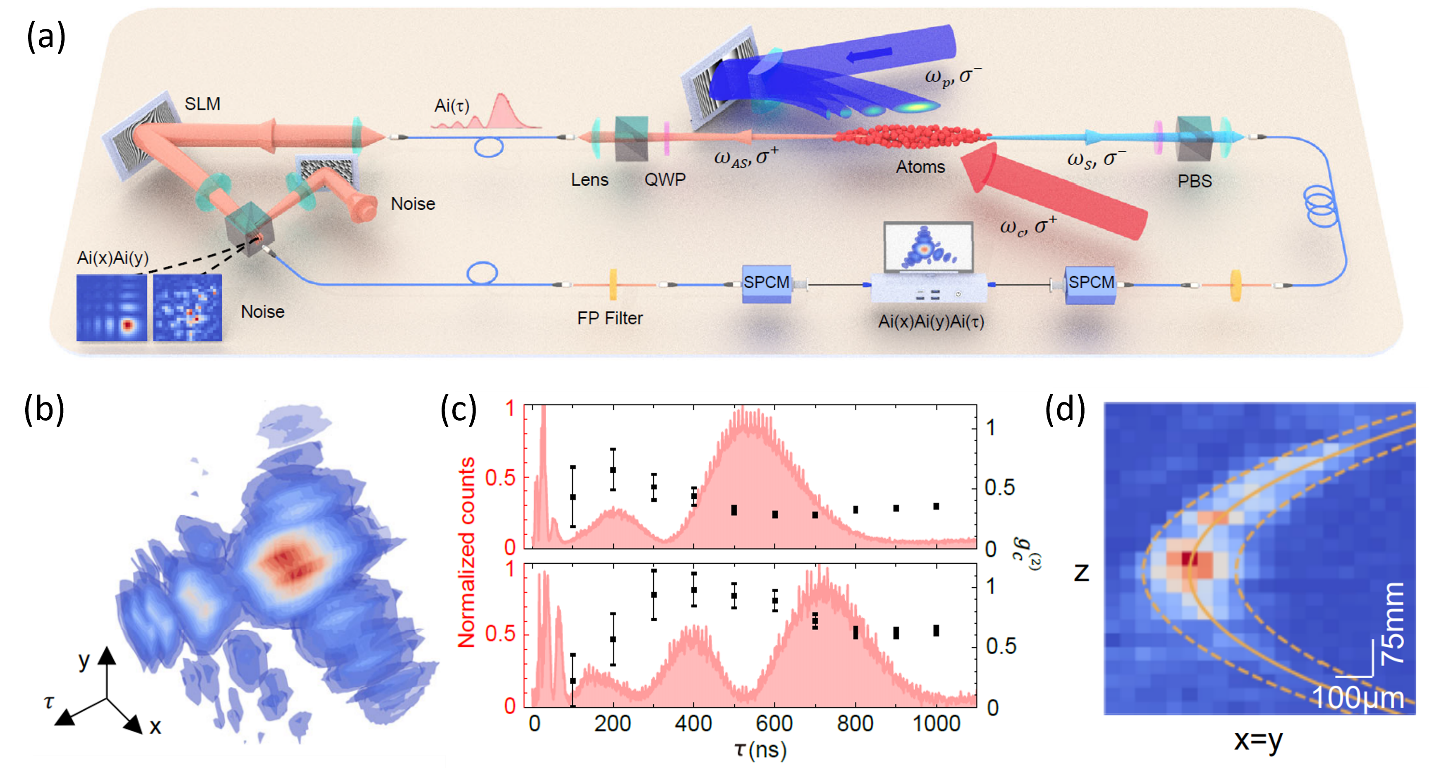Researchers make important progress in single-photon-manipulation
2024-04-08
Encoding quantum information and conveying it efficiently to a long-distant node using a single photon is essential for any communication between quantum nodes, and, at the same time, significant in quantum information security. Photons, as information carriers, fly with the highest speed in vacuum, and are insensitive to environmental disturbance. Further, quantum information can be encoded in the various degrees of freedom of a photon, such as polarization, orbital angular momentum, and frequency, among others, which can dramatically increase the information capacity of a quantum communication link. However, even a single photon suffers from dispersion, spreading, and diffraction, which is common for classical optical signals in long-distance transportation.
Airy beams have exceptional propagation properties, such as non-diffraction and self-healing, while the Airy function is a unique non-spreading solution for one-dimensional propagation equation. Up to now, the generation of propagation-invariant packets by simultaneously manipulating their spatial and temporal degrees of freedom has only been achieved in the classical regime and has never been realized in the single-photon quantum realm.

Associate Professor Jiefei Chen’s research group from the Shenzhen Institute for Quantum Science and Engineering (SIQSE) at the Southern University of Science and Technology (SUSTech) has recently made a breakthrough in generating propagation invariant single Airy photons by simultaneously sculpting their shape in space and time. Their work has demonstrated for the first time a spatiotemporal single-photon bullet in the quantum realm by exploiting the slow light effect of cold atomic gases.
Their study, entitled “Spatiotemporal Single-Photon Airy Bullets”, has been published in Physical Review Letters, a top international academic journal in physics, and was highlighted in the Viewpoint segment of Physics Magazine.
The researchers’ observations have been enabled by fusing cutting-edge methodologies from cold atomic gases and non-diffracting optics in the quantum regime. A versatile space-to-time mapping of slow light has been used in conjunction with single-photon spatial modulation to produce spatiotemporally invariant Airy photon bullets that are impervious to both diffraction and dispersion effects. As such, these wavepackets can find unique applications in quantum communication and information encoding, single-photon microscopies, and non-invasive bioimaging. One of the most significant breakthroughs in this work is that through the synergy of Airy non-diffraction with sub-Poissonian photon correlations, they observed an exclusively unique quantum distortion-resistant camouflaging effect that is not possible in the classical domain.

Figure 1. Experimental observation of spatiotemporal propagation-invariant single photons. (a) Optical setup for the generation of single Airy photons. (b) Experimentally observed single-photon Airy bullet. The spatial vectors correspond to 100 µm and the temporal one to 100 ns. (c) Temporal waveforms and the associated self-correlations of the generated nonclassical Airy wavepackets. (d) Curved trajectory of non-diffracting single-photon Airy wavepackets.
In the experiment, the researchers exploit the spectral properties of cold atomic gases to generate and shape the wavefunction of entangled pairs of photons. Initially, a laser-cooled atomic ensemble is prepared at a temperature of one hundred microkelvin. Subsequently, it is released from the magneto-optical trap, and photon generation takes place. As illustrated in Figure 1 (a), an Airy-shaped classical laser pump beam is combined with a coupling beam to create by a space-to-time mapping technique nonclassical light with a characteristic Airy temporal waveform. The single photons are spatially shaped with a spatial light modulator to create an Airy single-photon bullet that is recorded after one of the entangled photons is treated as a trigger.
An optical bullet is a light wavepacket that remains practically undistorted over propagation and has been observed for the first time in the quantum realm. The experimentally observed spatiotemporal single-Airy photons are presented in Figure 1 (b). Such wavepackets have been observed earlier only in the classical regime, and for photon numbers more than ten orders of magnitude larger than in the current experiments. In Figure 1 (c), the temporal waveforms, corresponding to normalized two-photon coincidence counts, spanning one microsecond have been measured.
To verify unequivocally the nonclassical nature of these wavepackets, Professor Chen’s group measured the self-correlation of the generated Airy photons and found them always lower than one for both two and three-lobe temporal waveforms. Finally, the intriguing property of spatially shaped Airy photons moving along parabolic trajectories has also been experimentally demonstrated as shown in Figure 1 (d), where the curved path of the maximum of the photon density probability is displayed.
It is envisioned that this work could open up new possibilities in generating novel classes of nonclassical photon sources with long temporal coherence and resilience to propagation-induced distortion. Non-paraxial spatiotemporal bullets and multi-dimensional storage of quantum information in cold atomic gases can now be pursued in follow-up experiments. Finally, these results can be directly utilized in any system that supports slow light, such as rare earth ion-doped crystals and photonic microcavities.
Doctoral student Jianmin Wang and Assistant Researcher Ying Zuo of SIQSE are the first and second authors of this work, respectively. Associate Professor Jiefei Chen and Researcher Georgios Siviloglou, both of SIQSE, are the corresponding authors. Xingchang Wang, Presidential Postdoctoral Fellow of SUSTech, also made important contributions to this study. The collaborator of the research group, Professor Demetrios Christodoulides from the University of Southern California (USC, USA), provided invaluable theoretical support.
This work was supported by the National Natural Science Foundation of China (NSFC), Guangdong Provincial Key Laboratory, and the Shenzhen Institute for Quantum Science and Engineering (SIQSE).
Paper link: https://journals.aps.org/prl/abstract/10.1103/PhysRevLett.132.143601
Highlight in Viewpoint of Physics Magazine: https://physics.aps.org/articles/v17/53




